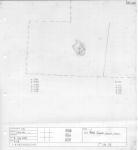Interpretation
-
- this representes a phase of the heart\'s use, as evidence by presence of badly burn tile on the surface
-
- Darian Marie Totten
- 24-7-2009
Site Photo
- No records attached.
Description
- color, compaction
- trowel
- see plan
- sandy clay
- red-white
- compact
- disturbed by later medieval post-hole
- artificial
- small rocks
- charcoal
- broken bricks, mortar fragments, ceramics
- This stratum presents a regular surface with slight slope to the south and west. It was composed of a reddish soil matrix that displayed evidence of burning. A badly decomposed fragmentary tile was found at the center. Inclusion included charcoal, which was concentrated predominantly on the eastern and southern limits of this stratum. Other inclusion were found in large concentration and randomly distributed throughout the stratum. While compact, due to the sand in the clay, it troweled easier than expected. The interface with the stratum below was noted by differences in color and consistency.
- The stratum identified and excavated in its entirety. There was no discernible pattern to the distribution of the reddish color in the stratum.
- early monastery
- good
Ceramic Inventory
- nothing diagnostic
| Total fragments | |
|---|---|
| 2 | |
| 3 |
Basic Information
- Stratum of rubefied clay under stratum SU 8093
Plan
Record Details
-
- Lisa Fentress
-
- Darian Marie Totten
- 8-7-2009
- Ismini Miliaresis
- 14-7-2009
